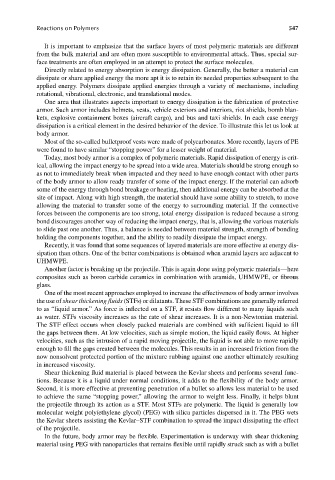Page 584 - Carrahers_Polymer_Chemistry,_Eighth_Edition
P. 584
Reactions on Polymers 547
It is important to emphasize that the surface layers of most polymeric materials are different
from the bulk material and are often more susceptible to environmental attack. Thus, special sur-
face treatments are often employed in an attempt to protect the surface molecules.
Directly related to energy absorption is energy dissipation. Generally, the better a material can
dissipate or share applied energy the more apt it is to retain its needed properties subsequent to the
applied energy. Polymers dissipate applied energies through a variety of mechanisms, including
rotational, vibrational, electronic, and translational modes.
One area that illustrates aspects important to energy dissipation is the fabrication of protective
armor. Such armor includes helmets, vests, vehicle exteriors and interiors, riot shields, bomb blan-
kets, explosive containment boxes (aircraft cargo), and bus and taxi shields. In each case energy
dissipation is a critical element in the desired behavior of the device. To illustrate this let us look at
body armor.
Most of the so-called bulletproof vests were made of polycarbonates. More recently, layers of PE
were found to have similar “stopping power” for a lesser weight of material.
Today, most body armor is a complex of polymeric materials. Rapid dissipation of energy is crit-
ical, allowing the impact energy to be spread into a wide area. Materials should be strong enough so
as not to immediately break when impacted and they need to have enough contact with other parts
of the body armor to allow ready transfer of some of the impact energy. If the material can adsorb
some of the energy through bond breakage or heating, then additional energy can be absorbed at the
site of impact. Along with high strength, the material should have some ability to stretch, to move
allowing the material to transfer some of the energy to surrounding material. If the connective
forces between the components are too strong, total energy dissipation is reduced because a strong
bond discourages another way of reducing the impact energy, that is, allowing the various materials
to slide past one another. Thus, a balance is needed between material strength, strength of bonding
holding the components together, and the ability to readily dissipate the impact energy.
Recently, it was found that some sequences of layered materials are more effective at energy dis-
sipation than others. One of the better combinations is obtained when aramid layers are adjacent to
UHMWPE.
Another factor is breaking up the projectile. This is again done using polymeric materials—here
composites such as boron carbide ceramics in combination with aramids, UHMWPE, or fi brous
glass.
One of the most recent approaches employed to increase the effectiveness of body armor involves
the use of shear thickening fl uids (STFs) or dilatants. These STF combinations are generally referred
to as “liquid armor.” As force is inflected on a STF, it resists flow different to many liquids such
as water. STFs viscosity increases as the rate of shear increases. It is a non-Newtonian material.
The STF effect occurs when closely packed materials are combined with sufficient liquid to fi ll
the gaps between them. At low velocities, such as simple motion, the liquid easily fl ows. At higher
velocities, such as the intrusion of a rapid moving projectile, the liquid is not able to move rapidly
enough to fill the gaps created between the molecules. This results in an increased friction from the
now nonsolvent protected portion of the mixture rubbing against one another ultimately resulting
in increased viscosity.
Shear thickening fluid material is placed between the Kevlar sheets and performs several func-
tions. Because it is a liquid under normal conditions, it adds to the flexibility of the body armor.
Second, it is more effective at preventing penetration of a bullet so allows less material to be used
to achieve the same “stopping power,” allowing the armor to weight less. Finally, it helps blunt
the projectile through its action as a STF. Most STFs are polymeric. The liquid is generally low
molecular weight poly(ethylene glycol) (PEG) with silica particles dispersed in it. The PEG wets
the Kevlar sheets assisting the Kevlar–STF combination to spread the impact dissipating the effect
of the projectile.
In the future, body armor may be flexible. Experimentation is underway with shear thickening
material using PEG with nanoparticles that remains flexible until rapidly struck such as with a bullet
9/14/2010 3:43:16 PM
K10478.indb 547 9/14/2010 3:43:16 PM
K10478.indb 547

